- Home
- J. A. Jance
Partner In Crime
Partner In Crime Read online
Partner In Crime
J. A. Jance
A terrifying truth is buried at the juncture where lethal greed and unassailable power converge.
The dead woman was an artist recently arrived from Washington State, cruelly cut down in the early stages of a promising career. Now all that remains of Rochelle Baxter lies on a cold slab in the Cochise County morgue, and Sheriff Joanna Brady knows that murder has once again infected her small desert community.
But there is more to this homicide than initially meets the eye – and more to the victim, who died while supposedly under the conscientious protection of the government.
A big-city legal establishment has no faith in the abilities of a small-town sheriff, let alone a female sheriff. Instructed to swallow her indignation, Joanna awaits the arrival of the “help” Washington ’s attorney general is sending her: the newest member of the state’s Special Homicide Investigation team – a man named Beaumont.
Bisbee, Arizona, is the last place J.P. Beaumont wants to be. The ghosts of a painful past are too numerous there, and his reluctant “partner,” Sheriff Brady, resents his intrusion and cannot help but make her feelings known. But the road they are forced to travel together is taking some unexpected turns, running two dedicated servants of the law headfirst into the impenetrable stone walls of a shocking conspiracy of silence. For Brady and Beaumont ’s hunt is disturbing a very deadly nest of rattlers, and suddenly trust is the only option they have.
On their own in the Arizona desert, they know death can be cold and quick. And nobody is watching their backs here… they’ll have to watch each other’s.
J. A. Jance
Partner In Crime
The tenth book in the Joanna Brady series, 2002
For Mr. Bone. For Sunny, Huck, and Zeke.
For the Nickkis (both of them). For Tess and Mandy.
Azalea and Scratch. Boots and Barney.
Daphne and Ag.
And last but not least, for Daisy Mae.
Prologue
“WELL?” DEIDRE CANFIELD ASKED, as she mopped her dripping forehead and straightened the last picture. “What do you think?” Rochelle Baxter stood back and eyed the painting critically. It was one of sixteen pieces in her first-ever gallery showing. With occasional heavy-lifting help from Dee’s boyfriend, Warren Gibson, the two women had spent the previous six hours hanging and rehanging the paintings in Dee’s recently remodeled and – for anyone doing physical labor – incredibly overheated Castle Rock Gallery in Bisbee, Arizona. For Dee it was a new beginning. For Rochelle, it was something else.
“It’s fine,” she said. Then, seeing how her lack of enthusiasm caused a cloud of concern to cross Dee’s broad face, Rochelle added quickly, “It’s great, Dee. Really, it’s fine.”
“I’m glad you like it,” Dee said. “And don’t worry. I know this show is going to be a huge success. You heard the phone calls that came in about it just today. I’m betting we’ll have an overflow crowd for tomorrow’s grand opening.”
Deidre Canfield may have been convinced, but Rochelle wasn’t so sure. “I hope so,” she said dubiously.
Dee grinned. “What’s wrong, Shelley? Sounds like you’re suffering from a case of opening-night jitters.”
“Maybe so,” Rochelle admitted. “In fact, probably so.”
“Take my word for it,” Dee assured her. “I’ve been managing art galleries for years. I know what people like, and I’m telling you, they’re going to love your stuff. What worries me is that we’ll sell out so fast that some people will go away disappointed. I’m a lot more concerned about that than I am about no one showing up.”
Turning away, Dee walked over to her desk and picked up her purse. “ Warren wants me to give him a lift to the house, and I have to stop by the bank before it closes. Want to ride along?”
Rochelle shook her head. “You two go ahead. If you don’t mind, Dee, I’d rather stay here. I want to be alone with the paintings for a little while.”
Dee smiled sympathetically. “It must seem like saying good-bye to a bunch of old friends.”
Rochelle nodded, but she kept her face averted so the tears welling up in her eyes didn’t show. Dee ’s comment was far closer to the mark than Rochelle Baxter wanted to admit. “Something like that,” she murmured.
Dee shrugged. “Suit yourself,” she said. “Stay as long as you like. I’ll be back in forty-five minutes or so. I also need to do some last-minute consulting with the caterer. I’ll lock the door and put up the closed sign. If someone wants in, ignore them. Don’t bother opening the door. Eventually they’ll get the message and go away. If you have to leave before I get back, pull the door shut behind you.”
“Will do,” Rochelle replied.
Dee and Warren left then, walking out into the warm autumn weather of a late-October Arizona afternoon. They made an incongruous, Jack Sprat sort of couple. Warren was tall and lanky and looked as though he’d never eaten a square meal in his life. Dee was short and almost as wide as she was tall. He wore a faded denim shirt, frayed jeans, and equally worn tennis shoes. Dee ’s roly-poly figure was swathed in a flowing tie-dyed smock that covered her from her plump neck to the toes of her aging Birkenstocks. The only similarity lay in their hairdos. Both wore their hair pulled back into single braids, although Dee’s gun-metalcolored plait was a good two feet longer than Warren ’s.
The afternoon temperature was a mild eighty-three degrees. Nevertheless, Dee insisted on keeping a reflective sunshade inside the windshield of her elderly Pinto station wagon. Rochelle watched as Warren pulled the sunshade out of the window and stowed it in the backseat. Then he climbed into the rider’s side of the multicolored rattletrap vehicle whose dented panels had been painted in vivid shades of lacquer that almost rivaled Deidre’s equally multicolored smock. Dee crammed herself behind the steering wheel.
After three separate tries, the touchy old engine finally wheezed to life. Driving with little-old-lady concentration, Dee eased the Pinto into what passed for rush-hour traffic in Bisbee and headed down Tombstone Canyon, leaving Rochelle to marvel at how a plump, wide-faced, oddly dressed white woman had, in the last few months, become both her good friend as well as an enthusiastic and unflagging artistic booster.
It was Dee Canfield who, after seeing Rochelle’s paintings, had decided on mounting a one-woman show. “Reminiscent of Norman Rockwell,” Dee had pronounced upon viewing Rochelle’s collection of work. “People won’t be able to keep from buying it. It has that same old-fashioned, uncomplicated look and feel to it. There are a lot of people out there who are sick and tired of so-called artists who throw globs of paint on canvas and pronounce it ‘fine art.’ “
Rochelle didn’t entirely share Dee ’s confidence about the salability of her work. There was good reason that her paintings were “reminiscent of” Norman Rockwell. As a child growing up in Macon, Georgia, Rochelle had pored over a book – one of her grandmother’s coffee-table books – that was chock-full of Norman Rockwell’s paintings. She had paged through each picture one by one, focusing all her attention and wonder on the occasional black people she saw depicted there – children and old people and ordinary adults whose appearance resembled her own.
Those few dark-skinned people in the paintings, like Rockwell’s other subjects, were caught while engaged in the most mundane of behaviors – standing outside a barbershop, riding in a wagon, playing with a ball, blowing on a harmonica. She had studied each picture with painstaking care, noticing how the artist had used light and dark to create the subtle variations of skin color. She had marveled at how Rockwell had captured intimate scenes in a way that made her feel as though she, too, knew the people depicted there. But most of all, seeing Rockwell’s work had made her want to emulate him –
to paint her subjects with the same respect and dignity he had accorded those he had painted.
Now Rochelle had. Her paintings were finished and framed and hanging on the walls of Dee ’s gallery. But would anyone buy them? That she doubted. In a community populated by precious few African-Americans, Shelley wondered how much commercial appeal her work would have. Based on demographics alone, it seemed unlikely to her that there would be an overwhelming demand for the paintings. Still, she had allowed herself to be dragged along by Dee ’s unbridled enthusiasm as well as by the encouragement and stubborn-minded insistence of her new friend, LaMar Jenkins.
As far as Rochelle knew, LaMar was the only other African- American currently living in Bisbee. Everyone else called him Bobo, but Shelley preferred the quiet dignity of his given name.
If Deidre Canfield was Rochelle’s booster and cheerleader, LaMar Jenkins was her champion. It was no accident that the picture she turned to now was one of him, grinning amiably and leaning, with studied ease, against the back gate of his prized bright yellow El Camino. LaMar was a man in his late forties. His well-conditioned, muscle-hardened body may have belied his age, but there was wisdom in the lines that etched his face, and a sprinkling of gray peppered his short-cropped hair. Behind him and just overhead hung a wooden sign that said blue moon saloon and lounge, the Brewery Gulch watering hole he had recently sold.
Of all the portraits hanging in the gallery, that was the only one with the telltale red dot that indicated it was already sold. LaMar, subject and purchaser, hadn’t wanted the painting to be exhibited at all, but Dee had insisted. For her, having sixteen pieces represented some kind of magic number. Without LaMar’s portrait, entitled simply Car and Driver, the show would have been one painting short. So there it was.
Looking at it – seeing LaMar’s engaging grin and the reined-in strength of his powerful forearms – caused a lump to grow in Rochelle’s throat. She had done something she never should have done, something she had countless times forbidden herself to do – she had allowed him to get too close and, as a result, had become too involved. That kind of involvement was dangerous for both of them now that LaMar “Bobo” Jenkins was about to run for mayor of Bisbee.
The next municipal election was almost a year away, but Rochelle understood the necessity of distancing herself now rather than later. Once LaMar Jenkins officially declared his candidacy, he would be newsworthy. He would be an African-American running for office in a town where everyone considered himself part of an oppressed minority. That was bound to attract attention to LaMar as well as to anyone connected with him.
During the months Rochelle Baxter had lived in the community of Naco, Arizona, a few miles outside of Bisbee, she had noticed how the lady county sheriff, Joanna Brady, and her family were routinely covered in both local and statewide media venues. When the sheriff had remarried, the wedding itself had made headlines in the local paper, The Bisbee Bee. Sheriff Brady was, after all, a public figure. Several months earlier, when the sheriff’s young daughter and a friend had stumbled over the body of a murdered woman while on a Girl Scout campout, that, too, had been front-page fodder – and not just in Bisbee, either.
Rochelle couldn’t afford to live in the unblinking focus of a media microscope. Being a part of that kind of associated publicity – where a picture of Rochelle accompanying LaMar to some campaign event might well be beamed all over the country – was something she could ill afford. She had made up her mind. No matter how much it hurt, she would break off the relationship. And the breakup had to come soon. Now. While she could still do it and make it stick.
Sighing, she turned away from LaMar’s portrait and wandered through the building to view the other pictures hanging on the freshly painted stuccoed walls. Castle Rock Gallery occupied a series of small buildings that had been cobbled together over time. Rochelle theorized that a previous owner or owners had added on and stitched the pieces together in a haphazard fashion, as both spirit and funds had allowed. As a result, the rooms – of various sizes and shapes – were arranged with wildly varying floor elevations. With an eye to forestalling a potential lawsuit from some crusading Americans with Disabilities Act activist, Dee and Warren had installed a complex series of ramps that linked the rooms and uneven floor levels together.
Around the corner from LaMar’s grinning portrait but in another room altogether hung Rochelle’s favorite piece, one titled A Boy and His Dog. The two figures sat side by side on the edge of a large porch overlooking a sun-drenched front yard with a tree-lined paved street beyond a picket fence. One of the boy’s arms was flung casually across the golden Lab’s sturdy shoulder. Sitting with only their backs showing, they were framed by a doorway as though the artist, standing just inside the shadowy house, had painted them from that vantage point.
Of course, the boy was not really “a boy” at all. It was really Tommy, Rochelle’s younger brother. And “his dog” was really Scooter. Rochelle remembered coming out through the front door one summer’s day and seeing them sitting together like that. Tommy had been only ten at the time and Rochelle twelve. What hadn’t shown then – and what didn’t show now in the painting – was the leukemia that was already robbing Tommy of his childhood and obliterating his ability to play outdoors on that carefree summer’s day. What also didn’t show on that warm and lazy Georgia afternoon was how, a few months later, when an ambulance carrying Tommy to the hospital was speeding away from the house, lights flashing and siren blaring, Scooter went racing after it down the street, where he was struck by a car two intersections away. None of that showed in the picture, but it was all there, twenty-three years later, etched deeply into Rochelle’s still-grieving heart.
Two pictures away was another favorite. In it, Rochelle’s niece, Jolene, crouched, ball in hand, beneath a basketball hoop fastened high over her grandfather’s garage door. Her skin gleamed with sweat and her dark eyes glittered with clear determination. Her cornrows shone in the sunlight. The painting was titled Making a Basket, although the ball was still poised on the ends of Jolene’s fingertips as she prepared to spring upward.
A viewer would simply have to take it on faith that she had actually made the ball swish effortlessly through the hoop, but Rochelle didn’t. She knew for sure. She had been there, home on leave after Operation Desert Storm, playing a predinner pickup game with her sister’s teenage daughter. Jolene was married now and had two children of her own. Maybe three, for all Rochelle knew, but in her artist’s eye, Jolene was still young and innocent and with a world of possibility open to her.
Rochelle moved from one room to another, strolling up and down the various ramps. Standing in front of each painting, she allowed the images she had captured there to speak to her once more. In The Pastor and the Lamb she saw her father again. Roundly middle-aged and dressed in his bright red summer preacher’s robe, he leaned down to shake hands with a shy little boy who gazed worshipfully up at him over the grubby white Bible he clutched tightly in his other hand.
Next to that picture was one called Napping. In it, Rochelle’s grandmother, Cornelia, drowsed peacefully in her rocking chair while rays of early-afternoon sunlight streamed in through the sheer window curtains and transformed her silvery hair into a glowing halo.
Around the corner from Napping was the The Carver. An old man – Rochelle’s grandfather, his vitality not yet drained and his mahogany skin not yet tinged with the jaundice of kidney disease – sat on a kitchen chair and sharpened his knife on a soapstone while curls of newly whittled wood littered the floor around his feet.
A few feet away from The Carver was Homecoming. In that one, Rochelle’s mother, dressed in a suit and looking determinedly elegant, walked toward the front steps late one afternoon carrying her leather-bound briefcase balanced effortlessly in one hand. The slight smile on her lips showed that although she loved her work, she was nonetheless grateful to be coming home to her family – to her husband and children.
Concealed under the paint of that pictur
e and three of the others in the gallery was a never-finished self-portrait. Rochelle had tried to paint that one over and over again. Each time she had given up in frustration and covered the unfinished work over with some other painting. That was the magic of working with oils. If a painting didn’t come together, you could always render it invisible by burying it under layers of other colors. Gazing at her mother’s well-remembered and equally well-rendered features, Rochelle realized why she had never succeeded in painting herself. She knew who her mother was, but when it came to Rochelle Baxter, the artist wasn’t so sure.
Sighing, she turned away. Dee had been absolutely right when she said selling the paintings must be like saying good-bye to a group of old friends, but for Rochelle it went far beyond that. In painting the portraits, she had recalled those loved ones from the past and remembered why she had loved them. Now, knowing she would never see any of them again, it seemed as though she was letting go of them forever at the same time she was letting go of their portraits. Hail and farewell.
Finally, it was all too much. Walking through the empty gallery, a half-sob escaped Rochelle’s lips and she knew she was about to lose it. That shook her. If it could happen to her when she was all alone in the gallery, how would she manage to maintain her composure tomorrow night at the opening-night party, when the place would be crowded with people, all of them – according to Dee – potential buyers? What would she do if some nice lady asked the artist who that little boy was, sitting on the porch with his dog? And what if someone else wanted to know about that nice old lady napping so peacefully in her rocking chair?
Feeling the first subtle heart-pounding, breath-robbing symptoms of an oncoming panic attack, Rochelle bolted out of Castle Rock Gallery, slamming the door shut behind her. Anxiously she scanned the parking lot, afraid Dee and Warren might return before she could make good her escape. Her closed Camry had been sitting in full afternoon sunlight. Shivering and sweating at the same time, she sank, gasping for breath, into the cloth seat and welcomed the comforting warmth that surrounded her. She grasped the steering wheel and held on, hoping the heated plastic would help still her quaking hands. After a few long minutes, the panic attack subsided enough to allow her to start the car and drive away.

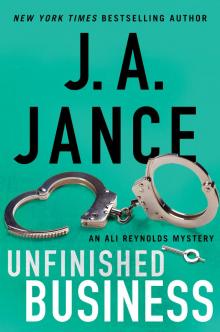 Unfinished Business
Unfinished Business Missing and Endangered
Missing and Endangered Man Overboard
Man Overboard The Old Blue Line
The Old Blue Line Trial by Fury
Trial by Fury Edge Of Evil
Edge Of Evil Field of Bones: A Brady Novel of Suspense (Joanna Brady Mysteries)
Field of Bones: A Brady Novel of Suspense (Joanna Brady Mysteries) After the Fire
After the Fire Deadly Stakes
Deadly Stakes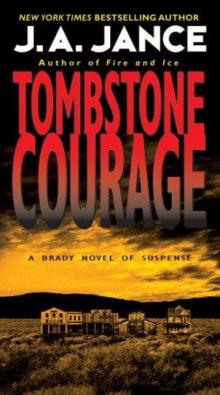 Tombstone Courage jb-11
Tombstone Courage jb-11 Justice Denied
Justice Denied J P Beaumont 16 - Joanna Brady 10 - Partner In Crime (v5.0)
J P Beaumont 16 - Joanna Brady 10 - Partner In Crime (v5.0) Dance of the Bones
Dance of the Bones Exit Wounds
Exit Wounds Left for Dead
Left for Dead Partner In Crime
Partner In Crime Brandon Walker 02 - Kiss Of The Bees (v5.0)
Brandon Walker 02 - Kiss Of The Bees (v5.0) Name Witheld jpb-13
Name Witheld jpb-13 Joanna Brady 01 - Desert Heat (v5.0)
Joanna Brady 01 - Desert Heat (v5.0) Proof of Life
Proof of Life Random Acts
Random Acts Day of the Dead bw-3
Day of the Dead bw-3 Shoot / Don't Shoot jb-3
Shoot / Don't Shoot jb-3 Without Due Process
Without Due Process Fatal Error ar-6
Fatal Error ar-6 Payment in Kind
Payment in Kind Long Time Gone
Long Time Gone Minor in Possession
Minor in Possession Stand Down
Stand Down Judgment Call
Judgment Call Betrayal of Trust jpb-20
Betrayal of Trust jpb-20 Hand of Evil
Hand of Evil Devil's ClawJ
Devil's ClawJ Lying in vait jpb-12
Lying in vait jpb-12 Day of the Dead
Day of the Dead Without Due Process jpb-10
Without Due Process jpb-10 Until Proven Guilty jpb-1
Until Proven Guilty jpb-1 Field of Bones
Field of Bones Devil’s Claw
Devil’s Claw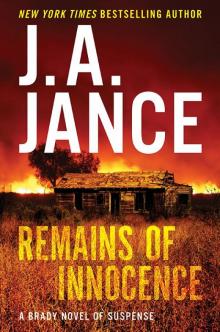 Remains of Innocence
Remains of Innocence Injustice for All
Injustice for All Web of Evil ar-2
Web of Evil ar-2 Paradise Lost jb-9
Paradise Lost jb-9 Improbable cause jpb-5
Improbable cause jpb-5 Skeleton Canyon
Skeleton Canyon No Honor Among Thieves: An Ali Reynolds Novella (Kindle Single)
No Honor Among Thieves: An Ali Reynolds Novella (Kindle Single) Dead to Rights
Dead to Rights Alison Reynolds 01 - Edge Of Evil (v5.0)
Alison Reynolds 01 - Edge Of Evil (v5.0) Ring In the Dead
Ring In the Dead Ring in the Dead: A J. P. Beaumont Novella
Ring in the Dead: A J. P. Beaumont Novella Clawback
Clawback Kiss the Bees bw-2
Kiss the Bees bw-2 Fire and Ice jpb-19
Fire and Ice jpb-19 Downfall
Downfall Deadly Stakes ar-8
Deadly Stakes ar-8 Fatal Error
Fatal Error Name Withheld
Name Withheld Duel to the Death
Duel to the Death Cold Betrayal
Cold Betrayal Betrayal of Trust
Betrayal of Trust Web of Evil
Web of Evil Outlaw Mountain
Outlaw Mountain Shoot Don't Shoot
Shoot Don't Shoot A Last Goodbye
A Last Goodbye Ali Reynolds 08 - Deadly Stakes
Ali Reynolds 08 - Deadly Stakes Hour of the Hunter: With Bonus Material: A Novel of Suspense
Hour of the Hunter: With Bonus Material: A Novel of Suspense Trial by Fire
Trial by Fire Exit Wounds jb-11
Exit Wounds jb-11 Hand of Evil ar-3
Hand of Evil ar-3 Failure to appear jpb-11
Failure to appear jpb-11 Tombstone Courage
Tombstone Courage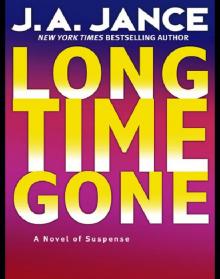 Long Time Gone jpb-17
Long Time Gone jpb-17 Kiss of the Bees w-2
Kiss of the Bees w-2 Edge of Evil ar-1
Edge of Evil ar-1 Cruel Intent
Cruel Intent Improbable Cause
Improbable Cause Still Dead
Still Dead Downfall (2016)
Downfall (2016) Justice Denied jpb-18
Justice Denied jpb-18 Damage Control
Damage Control Rattlesnake Crossing
Rattlesnake Crossing Desert Heat
Desert Heat Queen of the Night
Queen of the Night JP Beaumont 11 - Failure To Appear (v5.0)
JP Beaumont 11 - Failure To Appear (v5.0) Until Proven Guilty
Until Proven Guilty Minor in possession jpb-8
Minor in possession jpb-8 Left for Dead ar-7
Left for Dead ar-7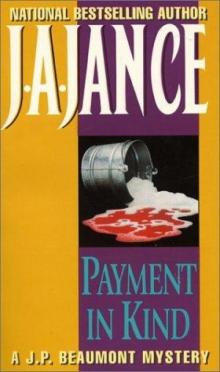 Payment in kind jpb-9
Payment in kind jpb-9 No Honor Among Thieves
No Honor Among Thieves